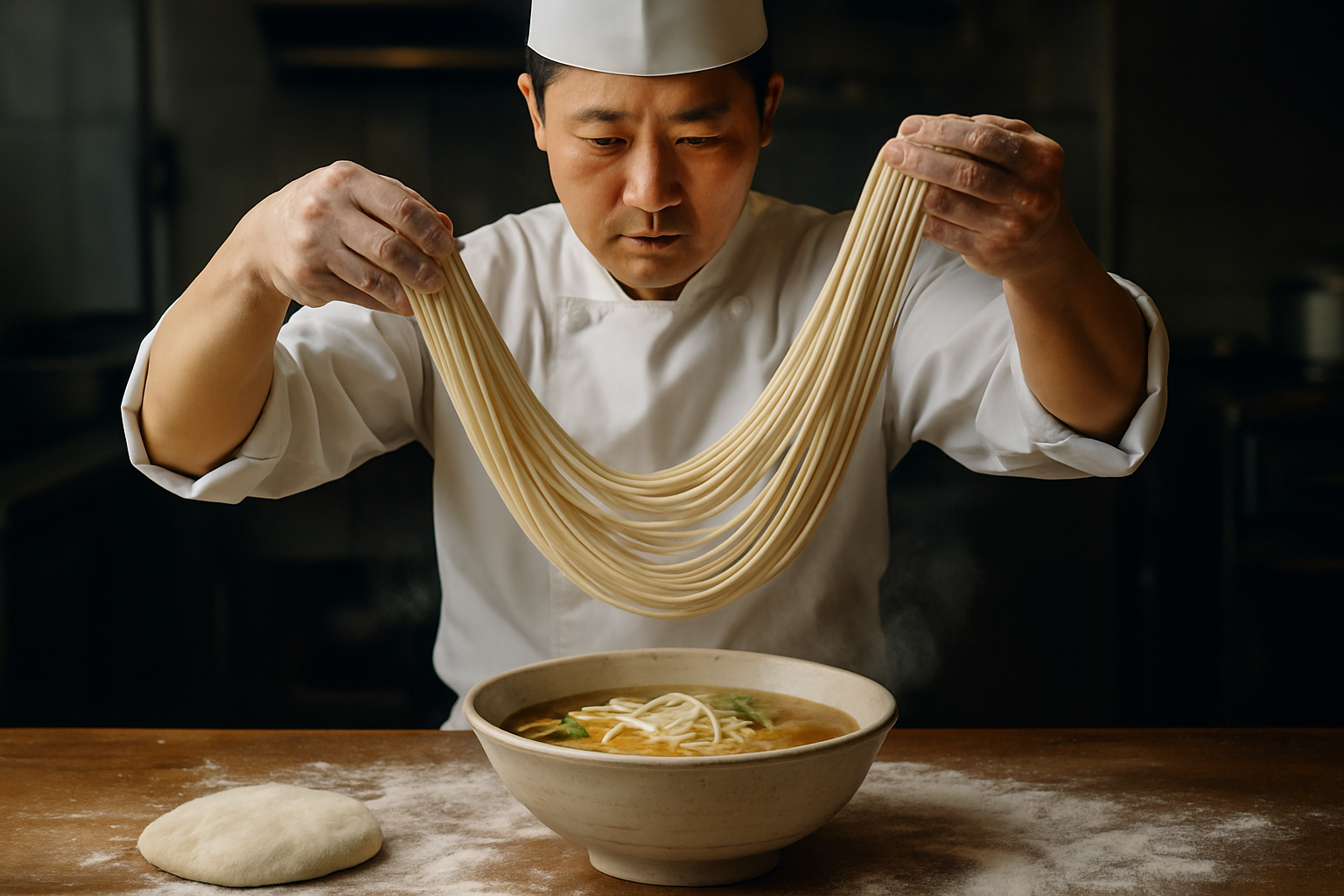Noodle Nirvana: The Art of Hand-Pulled Noodles
Slurp your way to culinary bliss with the mesmerizing craft of hand-pulled noodles. This ancient technique, perfected over centuries, transforms simple dough into silky strands of perfection. Join us as we dive into the world of hand-pulled noodles, exploring their history, mastering the technique, and discovering innovative twists on this timeless tradition.

A Noodle’s Journey Through Time
The origins of hand-pulled noodles can be traced back to the Qin Dynasty in China, over 2,000 years ago. Legend has it that Emperor Qin Shi Huang, fascinated by the long noodles’ resemblance to the Great Wall, declared them a symbol of longevity. As trade routes expanded, the technique spread across Asia, evolving into various regional specialties. In Japan, hand-pulled noodles became the foundation for ramen, while in Central Asia, they transformed into laghman, a hearty dish popular in Uyghur cuisine. Today, hand-pulled noodles continue to captivate food lovers worldwide, with noodle masters showcasing their skills in bustling markets and high-end restaurants alike.
Mastering the Pull: Techniques and Tips
Creating the perfect hand-pulled noodle requires a delicate balance of ingredients, technique, and timing. The dough must have just the right amount of elasticity to stretch without breaking. Noodle masters often use high-protein flour and add alkaline water to achieve the desired texture. The pulling technique involves a rhythmic dance of stretching and folding, with the dough looped around the hands and pulled outward. As the noodles lengthen, they’re repeatedly folded and stretched until the desired thickness is achieved. Temperature plays a crucial role, with many chefs preferring to work in cooler environments to prevent the dough from becoming too soft. With practice, home cooks can develop their own pulling style, experimenting with different flour blends and cooking methods.
Beyond Tradition: Innovative Twists on Hand-Pulled Noodles
While traditional hand-pulled noodles continue to delight, innovative chefs are pushing the boundaries of this ancient craft. Experimentations with alternative flours, such as buckwheat or rice flour, are creating gluten-free versions that maintain the characteristic chewiness. Some chefs are infusing the dough with natural colorants like beet juice or spinach powder, creating vibrant noodles that are as visually stunning as they are delicious. Fusion cuisines are also embracing hand-pulled noodles, incorporating them into unexpected dishes like noodle-wrapped sushi rolls or as a base for European-inspired sauces. These creative approaches are introducing hand-pulled noodles to new audiences and demonstrating the versatility of this timeless technique.
From Bowl to Plate: Serving Suggestions and Pairings
The beauty of hand-pulled noodles lies in their versatility. In traditional Chinese cuisine, they’re often served in a rich, savory broth with tender beef or lamb. However, these noodles can be adapted to countless flavor profiles and cooking styles. Try them stir-fried with vibrant vegetables and a spicy sauce for a quick weeknight meal. For a lighter option, serve them chilled with a tangy sesame dressing and crisp vegetables. Hand-pulled noodles also make an excellent base for fusion dishes, such as a Mediterranean-inspired noodle salad with olives and feta or a Mexican-inspired noodle soup with avocado and lime. When it comes to beverages, consider pairing these noodles with a crisp lager, a fruity white wine, or a refreshing iced tea to complement their chewy texture and rich flavors.
Noodle Know-How: Tips and Facts
• The ideal dough for hand-pulled noodles should rest for at least 30 minutes before pulling.
• Professional noodle pullers can create up to 256 noodle strands from a single piece of dough.
• The alkaline water used in many recipes helps give the noodles their distinctive yellow color and chewy texture.
• Hand-pulled noodles cook much faster than dried noodles, often requiring only 1-2 minutes in boiling water.
• The technique of hand-pulling noodles is considered an intangible cultural heritage in some regions of China.
As we’ve explored the fascinating world of hand-pulled noodles, it’s clear that this ancient technique continues to captivate food lovers and chefs alike. From its humble beginnings to modern innovations, the art of hand-pulling noodles represents a perfect blend of tradition and creativity. Whether you’re slurping a bowl of traditional lamian or experimenting with fusion creations, these noodles offer a unique culinary experience that engages all the senses. So why not embrace the challenge and try your hand at pulling your own noodles? With practice and patience, you might just discover your own noodle nirvana.





